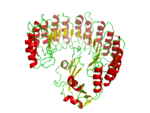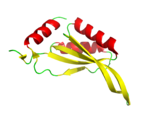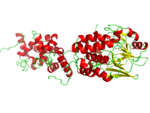Difference between revisions of "Sequence-based analyses Gaucher Disease"
(→Predictions) |
(→Secondary structure) |
||
| Line 81: | Line 81: | ||
[[File:ss_P10775.png|thumb|150px|right|<caption>Crsytal structure of 1DFJ (P10775). Red: alpha-helix, yellow: beta-sheet, green: coiled.</caption>]] |
[[File:ss_P10775.png|thumb|150px|right|<caption>Crsytal structure of 1DFJ (P10775). Red: alpha-helix, yellow: beta-sheet, green: coiled.</caption>]] |
||
</figure> |
</figure> |
||
| − | <xr id="fig:ss_P10775"/> depicts the crystal structure 1DFJ which refers to P10775. It has two domains: [http://scop.mrc-lmb.cam.ac.uk/scop/data/scop.b.d.bb.b.b.b.html d1dfji_] is a repeat domain consisting of altering alpha-helices and parallel beta-sheets. [http://scop.mrc-lmb.cam.ac.uk/scop/data/scop.b.e.f.b.b.b.html d1dfje_] contains long curved antiparallel beta-sheets and three alpha-helices. The alternating <tt>HHH</ |
+ | <xr id="fig:ss_P10775"/> depicts the crystal structure 1DFJ which refers to P10775. It has two domains: [http://scop.mrc-lmb.cam.ac.uk/scop/data/scop.b.d.bb.b.b.b.html d1dfji_] is a repeat domain consisting of altering alpha-helices and parallel beta-sheets. [http://scop.mrc-lmb.cam.ac.uk/scop/data/scop.b.e.f.b.b.b.html d1dfje_] contains long curved antiparallel beta-sheets and three alpha-helices. The alternating <tt>HHH</tt> and <tt>EEE</tt> regions in the following secondary structure annotations suit well with repetitive structure shown in <xr id="fig:ss_P10775"/>. Again, the PSIPRED predictions better match the DSSP assignments than Reprof. |
<pre> |
<pre> |
||
1 |
1 |
||
| Line 120: | Line 120: | ||
</pre> |
</pre> |
||
| − | Q9X0E6 |
+ | ==== Q9X0E6 ==== |
| + | <figure id="fig:ss_Q9X0E6"> |
||
| + | [[File:ss_Q9X0E6.png|thumb|150px|right|<caption>Crsytal structure of 1KR4 (Q9X0E6). Red: alpha-helix, yellow: beta-sheet, green: coiled.</caption>]] |
||
| + | </figure> |
||
| + | <xr id="fig:ss_Q9X0E6"> depicts the [http://scop.mrc-lmb.cam.ac.uk/scop/data/scop.b.e.bcj.f.c.f.html d1kr4a_] domain of 1KR4 which is made of three alpha-helices interrupted by beta-sheets. Reprof predicts too long helices. |
||
<pre> |
<pre> |
||
2 |
2 |
||
| Line 136: | Line 140: | ||
==== Q08209 ==== |
==== Q08209 ==== |
||
| + | <figure id="fig:ss_Q08209"> |
||
| + | [[File:ss_Q08209.png|thumb|150px|right|<caption>Crsytal structure of 1AUI (Q08209). Red: alpha-helix, yellow: beta-sheet, green: coiled.</caption>]] |
||
| + | </figure> |
||
| + | Q08209 contains the domain [http://scop.mrc-lmb.cam.ac.uk/scop/data/scop.b.b.ff.b.g.di.html d1auib_] and [http://scop.mrc-lmb.cam.ac.uk/scop/data/scop.b.e.dbg.b.e.g.html d1auia_] which are mainly assembled of alpha-helices (<xr id="fig:ss_Q08209"/>). PSIPRED predicts these alpha-helices considerably better than Reprof which suggests beta-sheets in some regions. |
||
<pre> |
<pre> |
||
14 |
14 |
||
| Line 169: | Line 177: | ||
=== Prediction accuracy/precision === |
=== Prediction accuracy/precision === |
||
| + | We compared the prediction performance of PSIPRED and Reprof via the Q3 score and the precision of the three secondary structure states H,E, and C. The Q3 score is identical to the accuracy, i.e. the number of correctly predicted states divided by the length of the protein. The precision of state X is the fraction of correct predictions of X, formally Precision(X)=TP(X)/(TP(X)+FP(X)). Table <xr id="ss_acc"/> shows the results: PSIPRED clearly outperforms Reprof in all for cases. PSIPRED achieves an average accuracy of 87% which is significantly higher than 58% in case of Reprof. |
||
<figtable id="ss_acc"> |
<figtable id="ss_acc"> |
||
{|border=1 style="border-collapse: separate; border-spacing: 0; text-align: center" |
{|border=1 style="border-collapse: separate; border-spacing: 0; text-align: center" |
||
Revision as of 16:31, 17 May 2012
Contents
Secondary structure
Knowing the secondary structure of a protein can shed light on its function since structure implies function. If the structure of a protein is known, secondary elements (helix, sheet, coiled) can be assigned to residues depending on their affinity to form hydrogen bonds. DSSP is the most common method to perform such secondary structure assignments. If the structure of a protein is unknown, secondary structure elements be be predicted by tools like PSIPRED or Reprof. The aim of this task was to analyse the secondary structure of different proteins and the compare the secondary structure predictions of PSIPRED and Reprof with the DSSP secondary structure assignments. Following sequences were taken into account:
| NAME | UniProtKB | PDB |
|---|---|---|
| Glucosylceramidase | P04062 | 1OGS |
| Ribonuclease inhibitor | P10775 | 1DFJ |
| Divalent-cation tolerance protein CutA | Q9X0E6 | 1KR4 |
| Serine/threonine-protein phosphatase | Q08209 | 1AUI |
Information about program calls and implementation details can be found in our protocol.
Predictions
<figtable id="tab:ss_mapping">
| Method | H | E | C |
|---|---|---|---|
| DSSP | H,G,I | E,B | T,S,' ' |
| PSIPRED | H | E | C |
| Reprof | H | E | L |
</figtable> For being able to better compare the different output format, we mapped the secondary structure definitions of all three methods onto the three letters H (helix), E (sheet), and C (coiled) according to table <xr id="tab:ss_mapping"/>. Regions of the UniProt sequences which were not present in the PDB file as well as regions where no DSSP assignment was possible were ignored.
P04062
<figure id="fig:ss_P04062">
</figure> Glycosylcermidase (P04062) is located the the membrane of lysosomes. It exhibits two domains which belong to the (1) glycosyl hydrolase domain fold and (2) then TIM beta/alpha-barrel fold. Both domains have hydrophobic beta sheets which anchor the protein in the membrane. <xr id="fig:ss_P04062"/> depicts the secondary structure elements of the corresponding crystal structure which coincide with the DSSP assignments. The following section shows the secondary structure annotations of the different methods: The predictions of PSIPRED better match with the DSSP assignments than Reprof. Reprof predicts sheets instead of helices in several regions. The resiudes of the beta-barell sheets are marked by asterisks.
40
ARPCIPKSFGYSSVVCVCNATYCDSFDPPTFPALGTFSRYESTRSGRRMELSMGPIQANHTGTGLLLTLQPEQKFQKVKG
Reprof CCCCCCCCCCCEEEEEEECCEECCCCCCCCCCCCCEEEEEEECCCCCEEEEECCCEECCCCCCEEEEEECCCCEEEEEEC
PSIPRED CCCCCCCCCCCCCEEEEECCHHCCCCCCCCCCCCCEEEEEEECCCCCCHHCCCCCCCCCCCCCCCEEEECCCCCCEEEEE
DSSP CECCCEEECCCCCEEEEEECCCCCECCCCCCCCCCEEEEEEEECCCCCCEEEEEECECCCCCCCEEEEEEEEEEEEECCE
120
FGGAMTDAAALNILALSPPAQNLLLKSYFSEEGIGYNIIRVPMASCDFSIRTYTYADTPDDFQLHNFSLPEEDTKLKIPL
Reprof CCCCCCHHHHHEEEEECCCCCCEEEEEEECCCCCEEEEEEECCCCCCEEEEEEEECCCCCCCEEEEECCCCCCCCCEEEE
PSIPRED EEEEHHHHHHHHHHHCCHHHHHHHHHHHCCCCCCEEEEEEEEECCCCCCCCCCCCCCCCCCCCCCCCCCCCHHHHHHHHH
DSSP EEEECCHHHHHHHCCCCHHHHHHHHHHHHCCCCCCCCEEEEEECCCCCCCCCCCCCCCCCCCCCCCCCCCHHHHCCHHHH
200
IHRALQLAQRPVSLLASPWTSPTWLKTNGAVNGKGSLKGQPGDIYHQTWARYFVKFLDAYAEHKLQFWAVTAENEPSAGL
Reprof EEHHHHHCCCCCEEEECCCCCCCEEEECCCECCCEECCCCCCCCCCHHHHHHHHHHHHHCCCCEEEEEEEEECCCCCCCE
PSIPRED HHHHHHHHCCCEEEEEEECCCCHHEEECCCCCCCCCCCCCCCHHHHHHHHHHHHHHHHHHHHCCCEEEEEEECCCCCCCC
DSSP HHHHHHHCCCCCEEEEEECCCCHHHECCCCCCCCCEECCCCCCHHHHHHHHHHHHHHHHHHHCCCCCCEEECCCCCCHHH
****** ***
280
LSGYPFQCLGFTPEHQRDFIARDLGPTLANSTHHNVRLLMLDDQRLLLPHWAKVVLTDPEAAKYVHGIAVHWYLDFLAPA
Reprof ECCCCEEEECCCCCCCCCEEEECCCCCCCCCCCCEEEEEEECCCCEECCCEEEEEECCCCCCEEEEEEEEEEEEEECCCC
PSIPRED CCCCCCCCCCCCHHHHHHHHHHHHHHHHHHCCCCCEEEEEECCCCCCHHHHHHHHHCCHHHHHHCCEEEEECCCCCCCCH
DSSP CCCCCCCCCECCHHHHHHHHHHCHHHHHHCCCCCCCEEEEEEEEHHHCCHHHHHHHCCHHHHCCCCEEEEEEECCCCCCH
******** *******
360
KATLGETHRLFPNTMLFASEACVGSKFWEQSVRLGSWDRGMQYSHSIITNLLYHVVGWTDWNLALNPEGGPNWVRNFVDS
Reprof CCECCCCCECCCCCEEEECCCCCCCEEEEEEEEECCCCCCCEEECEHHHHEEEEEEECCCCEEEECCCCCCEEEEECCCC
PSIPRED HHHHHHHHHHCCCCEEEEECCCCCCCCCCCCCCCCCHHHHHHHHHHHHHHHHHHHHEEEEEEEEECCCCCCCCCCCCCCC
DSSP HHHHHHHHHHCCCCEEEEEEEECCCCCCCCCCCCCCHHHHHHHHHHHHHHHHCCEEEEEEEECCECCCCCCCCCCCCCCC
******** ********
440
PIIVDITKDTFYKQPMFYHLGHFSKFIPEGSQRVGLVASQKNDLDAVALMHPDGSAVVVVLNRSSKDVPLTIKDPAVGFL
Reprof CEEEEECCCCCCCCCEEEECCCEEEECCCCCEEEEEEEECCCCCEEEEEECCCCCEEEEEEECCCCCCEEEECCCCEEEE
PSIPRED CEEEECCCCEEEECHHHHHHHHHHHHCCCCCEEEEEECCCCCCEEEEEEECCCCCEEEEEEECCCCCEEEEEEECCCEEE
DSSP CEEEEHHHCEEEECHHHHHHHHHHCCCCCCCEEEEEEECCCCCEEEEEEECCCCCEEEEEEECCCCCEEEEEEECCCEEE
520
ETISPGYSIHTYLWRRQ
Reprof EEECCCCEEEEEEEECC
PSIPRED EEECCCCEEEEEEEECC
DSSP EEEECCCEEEEEEECCC
P10775
<figure id="fig:ss_P10775">
</figure> <xr id="fig:ss_P10775"/> depicts the crystal structure 1DFJ which refers to P10775. It has two domains: d1dfji_ is a repeat domain consisting of altering alpha-helices and parallel beta-sheets. d1dfje_ contains long curved antiparallel beta-sheets and three alpha-helices. The alternating HHH and EEE regions in the following secondary structure annotations suit well with repetitive structure shown in <xr id="fig:ss_P10775"/>. Again, the PSIPRED predictions better match the DSSP assignments than Reprof.
1
MNLDIHCEQLSDARWTELLPLLQQYEVVRLDDCGLTEEHCKDIGSALRANPSLTELCLRTNELGDAGVHLVLQGLQSPTC
Reprof CCCCECHHCCCCCHHHHHHHHHHHCCEEEECCCCCCHHHHHHHHHHHHCCCCHHHHHHHHCCCCCCCHEEEHCCCCCCCC
PSIPRED CEEECCCCCCCHHHHHHHHHHHCCCCEEECCCCCCCHHHHHHHHHHHHHCCCCCEEECCCCCCCHHHHHHHHHHHHHCCC
DSSP CECCCECCCCCHHHHHHHHHHHCCCCEEECECCCCCHHHHHHHHHHHHCCCCCCEEECCCCCCHHHHHHHHHHHHCCCCC
81
KIQKLSLQNCSLTEAGCGVLPSTLRSLPTLRELHLSDNPLGDAGLRLLCEGLLDPQCHLEKLQLEYCRLTAASCEPLASV
Reprof EEEEECCCCCCCCHCCCCCCHHHHCHCHHHHHHCCCCCCCCHHHHHHHHHCCCCCHCCHHHHHHHHHHCCCCCCHHHHHH
PSIPRED CCCEEECCCCCCCHHHHHHHHHHHHCCCCCCEEECCCCCCCHHHHHHHHHHHHCCCCCCCEEECCCCCCCHHHHHHHHHH
DSSP CCCEEECCCCCCCCCHHHHHHHHHHHCCCCCEEECCCCCCHHHHHHHHHHHHHCCCCCCCEEECCCCCCCHHHHHHHHHH
161
LRATRALKELTVSNNDIGEAGARVLGQGLADSACQLETLRLENCGLTPANCKDLCGIVASQASLRELDLGSNGLGDAGIA
Reprof HHHHHHHHHHCCCCCCHHHHHHHHHCCCCCCHHHHHHHHHHCCCCCCCCCHHHHHHHHHCHCCHHHCCCCCCCCCHHHHH
PSIPRED HHHCCCCCEEECCCCCCCHHHHHHHHHHHHCCCCCCCEEECCCCCCCHHHHHHHHHHHHCCCCCCEEECCCCCCCHHHHH
DSSP HHHCCCCCEEECCCCCCHHHHHHHHHHHHHCCCCCCCEEECCCCCCCHHHHHHHHHHHHHCCCCCEEECCCCCCHHHHHH
241
ELCPGLLSPASRLKTLWLWECDITASGCRDLCRVLQAKETLKELSLAGNKLGDEGARLLCESLLQPGCQLESLWVKSCSL
Reprof HHCCCCCCCHHHHCHHEEEHCCCCCHHHHHHHHHHHHHHHHHHHHHHCCCCCCHHHHHHHHHHCCCCCCHHHHHHHHCHH
PSIPRED HHHHHHHHCCCCCCEEECCCCCCCHHHHHHHHHHHHCCCCCCEEECCCCCCCHHHHHHHHHHHHCCCCCCCEEECCCCCC
DSSP HHHHHHCCCCCCCCEEECCCCCCCHHHHHHHHHHHHHCCCCCEEECCCCCCHHHHHHHHHHHHHCCCCCCCEEECCCCCC
321
TAACCQHVSLMLTQNKHLLELQLSSNKLGDSGIQELCQALSQPGTTLRVLCLGDCEVTNSGCSSLASLLLANRSLRELDL
Reprof HHHHHHHHHHHHHCCHHHHHHHCCCCCCCCHHHHHHHHHHCCCCCEEEEEEECCCCCCCCCHHHHHHHHHHHCCHHHHCC
PSIPRED CHHHHHHHHHHHHHCCCCCEEECCCCCCCHHHHHHHHHHHCCCCCCCCEEECCCCCCCHHHHHHHHHHHHHCCCCCEEEC
DSSP EHHHHHHHHHHHHHCCCCCEEECCCCECHHHHHHHHHHHHHCCCCCCCEEECCCCCCEHHHHHHHHHHHHHCCCCCEEEC
401
SNNCVGDPGVLQLLGSLEQPGCALEQLVLYDTYWTEEVEDRLQALEGSKPGLRVIS
Reprof CCCCCCCHHHHHHHCCCCCCCCHHHHHHHCCCCCCHHHHHHHHHHHCCCCCCCECC
PSIPRED CCCCCCHHHHHHHHHHHHCCCCCCCEEECCCCCCCHHHHHHHHHHHHHCCCCEECC
DSSP CCCECCHHHHHHHHHHHCCCCCCCCEEECCCCCCCHHHHHHHHHHHHHCCCCEEEC
Q9X0E6
<figure id="fig:ss_Q9X0E6">
</figure> <xr id="fig:ss_Q9X0E6"> depicts the d1kr4a_ domain of 1KR4 which is made of three alpha-helices interrupted by beta-sheets. Reprof predicts too long helices.
2
ILVYSTFPNEEKALEIGRKLLEKRLIACFNAFEIRSGYWWKGEIVQDKEWAAIFKTTEEKEKELYEELRKLHPYETPAIF
Reprof EEEEECCCCHHHHHHHHHHHHHHHHHHHHCHCHHHCCCEEECEEECCHHHHHHHCCCHHHHHHHHHHHHHCCCCCCCHHE
PSIPRED EEEEEECCCHHHHHHHHHHHHHCCCEEEEEEEEEEEEEEECCCEEEEEEEEEEECCCHHHHHHHHHHHHHHCCCCCCEEE
DSSP EEEEEEECCHHHHHHHHHHHHHCCCCCEEEEEEEEEEEEECCEEEEEEEEEEEEEEEHHHHHHHHHHHHHHCCCCCCCEE
82
TLKVENVLTEYMNWLRESVL
Reprof HHHHHHHHHHHHHHHHHHCC
PSIPRED EEECCCCCHHHHHHHHHHCC
DSSP EECCCCEEHHHHHHHHHHCC
Q08209
<figure id="fig:ss_Q08209">
</figure> Q08209 contains the domain d1auib_ and d1auia_ which are mainly assembled of alpha-helices (<xr id="fig:ss_Q08209"/>). PSIPRED predicts these alpha-helices considerably better than Reprof which suggests beta-sheets in some regions.
14
TDRVVKAVPFPPSHRLTAKEVFDNDGKPRVDILKAHLMKEGRLEESVALRIITEGASILRQEKNLLDIDAPVTVCGDIHG
Reprof CCCEEEEECCCCCCCEEEEEEECCCCCCEEEEEHHHECCCCCCCEEEEEEEEECCCCEEECCCCCCCCCCCEEEEECCCC
PSIPRED CCCCCCCCCCCCCCCCCHHHCCCCCCCCCHHHHHHHHHCCCCCCHHHHHHHHHHHHHHHHHCCCEEEECCCEEEECCCCC
DSSP CCCCCCCCCCCCCCCECHHHHECCCCCECHHHHHHHHHCCCCECHHHHHHHHHHHHHHHHCCCCEEEECCCEEEECCCCC
94
QFFDLMKLFEVGGSPANTRYLFLGDYVDRGYFSIECVLYLWALKILYPKTLFLLRGNHECRHLTEYFTFKQECKIKYSER
Reprof HHHHHHEEEEECCCCCCCEEEEEEEECCCCEEEEEEEHHHHHHHCCCCCEEEEEECCCCCCEEEEEEEEEEEEEEEEECH
PSIPRED HHHHHHHHHHHCCCCCCCCEEECCCCCCCCCCCHHHHHHHHHHHHCCCCCEEEECCCCHHHHHHCCCCHHHHHHHHCCHH
DSSP CHHHHHHHHHHHCCCCCCCEEECCCCCCCCCCHHHHHHHHHHHHHHCCCCEEECCCCCCCHHHHHHCCHHHHHHHHCCHH
174
VYDACMDAFDCLPLAALMNQQFLCVHGGLSPEINTLDDIRKLDRFKEPPAYGPMCDILWSDPLEDFGNEKTQEHFTHNTV
Reprof HHHHHHHHCCCCCHHHHHCCCEEEEECCCCCCCCCHHHHHHHHCCCCCCCCCCCEEEEECCCCCCCCCCCCCCECCCCCE
PSIPRED HHHHHHHHHCCCHHHHHCCCCEEEECCCCCCCCCCHHHHHHCCCCCCCCCCCHHHHHHCCCCCCCCCCCCCCCCCCCCCC
DSSP HHHHHHHHHCCCCCEEEECCCEEEECCCCCCCCCCHHHHHHCCCCCCCCCCCHHHHHHHCEECCCCCCCCCCCCEEECCC
254
RGCSYFYSYPAVCEFLQHNNLLSILRAHEAQDAGYRMYRKSQTTGFPSLITIFSAPNYLDVYNNKAAVLKYENNVMNIRQ
Reprof CCEEEEECCCCEEEEHCCCCHHHHEHHHCCCCCCEEEEEECCCCCCCEEEEEEECCCEEEEECCCEEEEEECCCEEEEEE
PSIPRED CCCCCCCCHHHHHHHHHHCCCCEEEEHHHHHHHHHHHHHCCCCCCCCCEEEEEECCCCCCCCCCEEEEEEECCCCCEEEE
DSSP CCCCEEECHHHHHHHHHHCCCCEEEECCCCCCCCEEECCECCCCCCECEEEECCCCCHHHCCCCCEEEEEEECCEEEEEE
334
FNCSPHPYWLPNFMDVFTWSLPFVGEKVTEMLVNVLNICSSFEEAKGLDRINERMPPR
Reprof ECCCCCCCCCCCCCEEEEEECCCCCHHHHHHHHHHHEECCEHHHHCCCCHHCCCCCCC
PSIPRED ECCCCCCCCCCCCCCCCCCCHHHHHHHHHHHHHHHHHCCCCHHHHHHHHHHHHCCCCC
DSSP ECCCCCCCCCHHHCCHHHHHHHHHHHHHHHHHHHHHCCCCCHHHHHHHHHHHHCCCCC
Prediction accuracy/precision
We compared the prediction performance of PSIPRED and Reprof via the Q3 score and the precision of the three secondary structure states H,E, and C. The Q3 score is identical to the accuracy, i.e. the number of correctly predicted states divided by the length of the protein. The precision of state X is the fraction of correct predictions of X, formally Precision(X)=TP(X)/(TP(X)+FP(X)). Table <xr id="ss_acc"/> shows the results: PSIPRED clearly outperforms Reprof in all for cases. PSIPRED achieves an average accuracy of 87% which is significantly higher than 58% in case of Reprof. <figtable id="ss_acc">
| Method | Q3 | Precision H | Precision E | Precision C |
|---|---|---|---|---|
| P04062 | ||||
| PSIPRED | 0.831 | 0.830 | 0.872 | 0.810 |
| Reprof | 0.553 | 1.000 | 0.455 | 0.592 |
| P10775 | ||||
| PSIPRED | 0.941 | 0.959 | 0.960 | 0.919 |
| Reprof | 0.603 | 0.589 | 0.417 | 0.644 |
| Q9X0E6 | ||||
| PSIPRED | 0.890 | 1.000 | 0.895 | 0.720 |
| Reprof | 0.580 | 0.562 | 0.917 | 0.458 |
| Q08209 | ||||
| PSIPRED | 0.833 | 0.842 | 0.902 | 0.812 |
| Reprof | 0.579 | 0.762 | 0.293 | 0.743 |
</figtable>
Disorder
P04062
<figtable id="disorder_P04062">
| Method | Disorder regions | |
|---|---|---|
| IUPRED | 2, 3, 6, 90-93, 229-231, 235, 236 | |
| DisProt | ||
| Precision: 0% | Sensitivity: undef | Specificy: 98% |
</figtable>
P10775
Homolog: DP00554 <figure id="fig:disorder_P10775">
</figure>
<figtable id="disorder_P10775">
| Method | Disorder regions | |
|---|---|---|
| IUPRED | ||
| DisProt | 31-50 | |
| Precision: undef | Sensitivity: 0% | Specificy: 100% |
</figtable>
Q9X0E6
Q08209
<figure id="fig:disorder_Q08209">
</figure> DP00092 <figtable id="disorder_Q08209">
| Method | Disorder regions | |
|---|---|---|
| IUPRED | 1-6, 8, 383,384,424,425,432,434-439,443,445,448,449,455,458,463-521 | |
| DisProt | 1-13,390-414,374-468,469-486,487-521 | |
| Precision: 100% | Sensitivity: 52% | Specificy: 100% |
</figtable>




